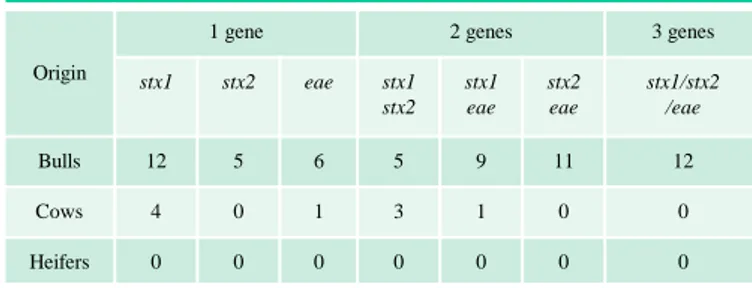INTRODUCTION
Escherichia coli producing Shiga toxins (STEC or ShigaToxigenic E. coli) and/or the attachment-effacement (AE) histological lesion (EPEC or EnteroPathogenic E. coli)
cause enteritis with (bloody) diarrhoea in humans and young calves and the haemolytic uremic syndrome (HUS) in humans. Infection of humans through consumption of foodstuffs (in)directly contaminated by cattle faeces (which are healthy intestinal carriers) is proved for STEC and suspected for EPEC. Besides the O157:H7 serotype, STEC and EPEC can belong to more than sixty O serogroups. Of them, 10 are regularly identified in humans and/or calves worldwide: O5, O26, O45, O103, O104, O111, O118, O121, O145 and O165. This study aimed at identifying the O serogroups of STEC and EPEC isolated from (i) diarrheic calves and (ii) healthy bovines at 2 slaughterhouses in Wallonia.
Range of O-serogroups of Shiga toxin-producing (STEC) and
enteropathogenic (EPEC) Escherichia coli in cattle in Wallonia
DUPREZ Jean-noël
1, JOUANT Ludovic
1, KORSAK Nicolas
2, SAULMONT Marc
3, MAINIL Jacques
11
Bacteriology, Infectious Diseases Department, and
2Food inspection, Department of Food Science, FARAH, Veterinary
Medicine Faculty, University of Liège, 4000 Liège;
3ARSIA, 5590 Ciney; BELGIUM
RESULTS
(i) the triplex PCR was performed in duplicate by two different manipulators on the E. coli isolated from diarrheic calves: 69 tested positive with the PCR for the stx1 and/or stx2 and/or eae genes (Table 1) and 81 negative for the 3 genes. 83 strains gave conflicting results and are being checked.
(ii) 69 enrichment broths of slaugtherhouse samples tested positive with the PCR for the stx1 and/or stx2 and/or eae genes (Table 2). The PCR-positive broth are being inoculated onto the 3 agar plates and 10 colonies from each plate are being picked-up and stored before further testing.
(iii) Right now, STEC and EPEC from diarrheic calves are being tested with the PCR for the O serogroups. (
DISCUSSION
- Animals for slaughter are, to some extent, holders of EPEC and STEC strains and thus represents a potential public health hazard.
- Moreover, there is no full correlation between the enterohaemolysin positive phenotype and the presence of the eae gene and / or those encoding the Shiga toxin. The use of enterohaemolysin agar might not be the best diagnostic test to isolate STEC and EPEC from diarrheic calves.
TABLE 1: No. E. coli positive with the triplex PCR for ...
1 gene 2 genes 3 genes
stx1 stx2 eae stx1/stx2 stx1/eae stx2/eae stx1/stx2/eae
47 1 7 3 9 1 1
REFERENCES
- Bardiau M, Muylaert A, Duprez JN, Labrozzo S, Mainil JG. (2010). Prevalence, molecular typing, and antibiotic sensitivity of enteropathogenic, enterohaemorrhagic, and verotoxigenic Escherichia coli isolated from veal calves. Tijdschr Diergeneeskd ;135(14-15):554-8.
- Mekata H, Iguchi A, Kawano K, Kirino Y, Kobayashi I, Misawa N (2014). Identification of O Serotypes, Genotypes, and Virulotypes of Shiga
Toxin-Producing Escherichia coli Isolates, Including Non-O157 from Beef Cattle in Japan. J Food Prot. 77(8):1269-74
Fig. 1: triplex PCR targeting the stx1, stx2 and/or eae genes
MATERIALS and METHODS
(i) 233 enterohaemolysin-positive E. coli were isolated at ARSIA from diarrhoeic calves after growth on EHLY Medium. They all were tested with a triplex PCR targeting the stx1, stx2 (Shiga toxins) and eae (AE lesion) genes (Fig. 1; Bardiau et al., 2010).
(ii) large intestine contents were sampled at 2 slaughterhouses in Wallonia from (165 <1 year-old bulls, 23 cows and 4 heifers) and grown overnight at 37°C in Lauryl sulfate Enterobacteriacae selective broth. The enrichment broths were assayed with the stx1/stx2/eae triplex PCR. Positive broths were inoculated onto agar plates (McConkey’s, Chroagar ES with tellurite and Chromagar STEC, Fig. 2) and 10 colonies from each plate were picked up for testing with the same triplex PCR.
(iii) all triplex PCR-positive E. coli were further assayed with a multiplex PCR targeting the specific genes coding for the O serogroups listed above (Mekata et al., 2014). (Fig 3)
TABLE 2: No. enrichment broths positive with the triplex PCR for ...
Origin
1 gene 2 genes 3 genes
stx1 stx2 eae stx1 stx2 stx1 eae stx2 eae stx1/stx2 /eae Bulls 12 5 6 5 9 11 12 Cows 4 0 1 3 1 0 0 Heifers 0 0 0 0 0 0 0
Fig. 2: Coliform in Mac conkey agar, tellurite resitant E.coli in Chromagar ES with tellurite , STEC (pink) and no pathogen E.coli (blue) in Chromagar STEC
eae stx2 stx1
Fig.3: 2 pentaplex PCR targeting O 5, 26, 103, 104, 111, 118, 121, 145, 157 and O165 (no control strain) serogroups genes
